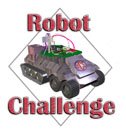There is a 3 Kilogram limit on the weight of a competing robot
AUTONOMY
There is to be no radio communication with the robot and infra red and ultrasonic sensing is to be limited to positioning sensors. There is to be no communication with any competitor or spectator of any kind. The robot must be totally autonomous
STARTING
The race will be commenced by an infra red beacon modulated at 40 kilohertz (such as a TV remote). (Instructions on how to do this.) Where the local conditions of the race are such that the use of the starting beacon is unreliable, then the judge may allow cars to be started by a push button on the robot. The judge will disqualify any robot that moves before the start signal (either infra red or verbal) or which is deliberately assisted in any way.
DAMAGE
The robot will not interfere with the track or any other robot other than in the course of bumping and normal wear and tear. Robots must not deliberately attach themselves to another robot or the track.
IMMOBILITY
Any robot that becomes immobile for more than 15 seconds will be immediately removed from the track and allowed a Technical Tap.
The Technical Tap consists of the robot remaining off the track for
30 seconds at which point the robot may re-enter the race at the
position it left the track.
However, where two (or more) robots of which at least one appears functional are locked together, the judge may separate the robots and either continue or restart the race. The judge will endeavour to avoid advantaging any robot in such a situation.
TRACK
The contest will be carried out on a black rubber track. The material is insertion rubber (as used in gaskets) which is 3mm thick. This will be laid out on a flat floor surface at the event.
The track will be 600mm wide. There will be 50mm wide gloss white tape along each edge. The black inner section of the track (between the white edges) will be 500mm wide.
The track will be rectangular in shape. Two sides will be 4 metres long and the other sides 2 metres long. The corners will turn through 90 degrees over a distance of 1 metres. The inside edge of the track at each corner will consist of an arc on a 400mm radius while the outside edge will be drawn on an arc of 1000 mm.
A strip of magnetic tape will be positioned across the width of the track 500mm before each corner (going in a clockwise direction). Robots may use this strip as positioning information at the discretion of the builder. The tape will be of advertising sheet magnet quality, and will be surface mounted on the track.
The track will be built such that any bumps that caused by the magnetic tape or perhaps joins in parts of the track will be less than 2mm in height. Race organisers will endeavour to maintain the
track but will take no responsibility where damage to the track is beyond their capacity to repair. Where the track is damaged the judge will rule as to the conduct of the race in discussion with the race organisers.
The Start/Finish line will be positioned across the middle of one of the longest straight sections of the track.

POSITIONING
Robots may cross the white edge. The inner edge of the white line may be used for positioning but the outer rim of the track cannot be used to guide the robot. It is acceptable for a robot to travel
with part of the robot covering the white line.
There will however be barriers in the corners to prevent short-cutting. These will be set 5cm back from the outer edge of the white line.

CONTEST DURATION
- The contest will necessitate the robot completing three laps of the track. Should any robot break any of the above rules it will be lifted clear of the track by the judge or nominee thereof.
- The winning robot will be the first to complete the 3 laps. Should all robots fail to complete the three laps, then the robot which travels the furthest distance in conformance with the rules will be declared the winner.
- QUALIFYING RUN and STARTING POSITIONS
Each robot will complete a qualifying run of one lap alone on the track.
Four robots will compete in each heat (if heats are needed). During each heat, robots will be placed on the track two abreast with choice of positions given based on the speed in completing the qualifying
run. Thus, the fastest robot in the qualifying run will have first choice in taking up a starting position through to the slowest robot having the last choice. The final positioning of robots for
starting will be as directed by the judge. Marks (using a non reflective substance such as pencil) will be made on the track indicating the extremities of each starting position. No part of any robot will be allowed to cover any part of the white lines or the marked extremities of the chosen starting position at the start of the race.
- DIRECTION of TRAVEL
Robots will travel in a clockwise direction. Any robot that travels in a reverse direction for more than 2 metres will be disqualified.
- APPEALS
The judges decision can be appealed against and the appellant will be disqualified and made to buy drinks for the other competitors.



